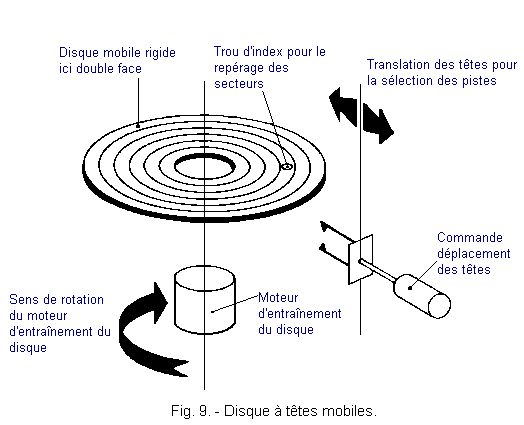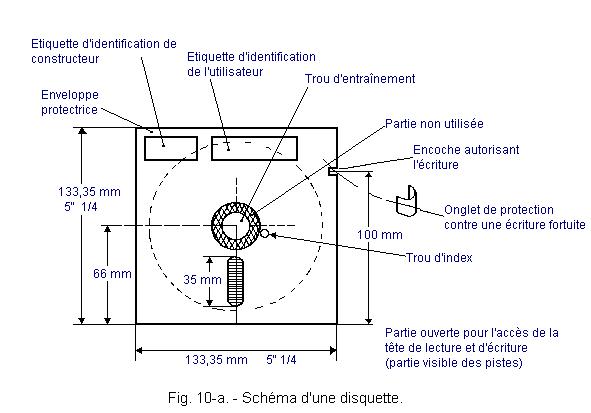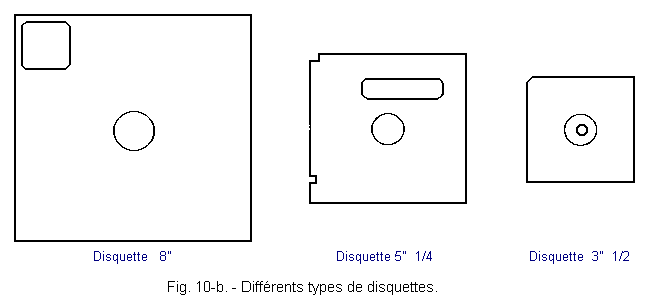Paper Memories - Magnetic Memories - Magnetic Discs - Optical Discs :
(Note : Although some lessons are a little old on this page, it's always good to know ...!)
As we have seen in the history of Theory 1, the concept of memory is an old and general concept.
Just as books (that is to say, writing) are a collective memory of man, the first memories for technical or industrial use are already old. These are the perforated paper strips of the barrel organ or the jacquard loom. An electronic flip-flop or a switch are also elementary memories as we will see.
1. - THE MEMORIES
1. 1. - DEFINITIONS
Memory : A memory is any system that can store information and dispose of it afterwards : for example, a bit, a byte (eight bits) or more generally a word of n bits or Byte.
Capacity : The capacity of a memory is the number of bits it can keep : it is usually expressed in bytes or kilobytes (1024 bytes) or in megabytes (1024 kilobytes).
We distinguish the theoretical or unformatted capacity of the formatted capacity. The latter is the really usable capacity after deduction of service bits needed in some technologies.
Temps d'accès : (Access time). Access time is the time needed to read or write information in memory.
Cycle time : The time between two successive read or write operations.
Mass memory : It is characterized by its large capacity and generally by a high access time.
Central memory of computation : It is generally characterized by its more limited capacity and a very short access time. The contents of the mass memories and the central memories will be the subject of a study of the microprocessor course.
Volatile memory : A memory is called volatile when it loses its information in the absence of power supply.
Address : In a memory, the data (succession of 1 bits 1 or 0) are stored in fictitious boxes whose order number is the address of the box considered. The search operation related to the use of the address is called : addressing.
Serial access memory : To read them, it is necessary to read the information in the order in which it was written.
Random Access Memory : Access to information is not done in a predetermined order.
In computer science, many systems for memorizing information have been successively used.
There are two groups of memories : the memories using a mechanical drive and the electronic memories.
Among the memories using a mechanical drive, we can distinguish several kinds : here are the main types.
![]() 1. 2. - PAPER MEMORIES
1. 2. - PAPER MEMORIES
1. 2. 1. - PERFORATED PAPER BANDS, MYLAR, BUT ALSO IN METAL (FIGURE 1).
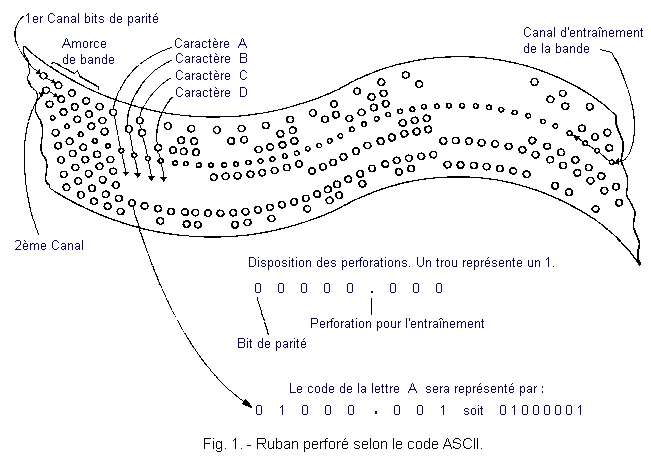
The perforated band is provided in the middle with a drive channel. The code corresponding to a character is written transversely through perforations which represent the bits at 1 or 0. The number of perforations (generally 1-bit) is even or odd, for this purpose a channel is reserved for the parity bit or odd parity.
There are many codes developed by each manufacturer. This system, which was widely used by electromechanical billers, is still used on some numerically controlled machines (milling machines, lathes, etc.).
It is slow, its access is serial : that is to say it is necessary to read the whole band in order, before reaching the desired data. It is gradually replaced by floppy disks.
1. 2. 2. - PERFORATED CARDS : 80 COLUMNS TYPE I.B.M. (FIGURE 2) :
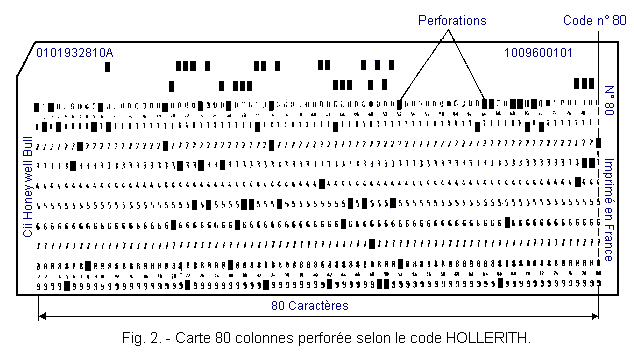
The codes are made by means of rectangular perforations according to a principle similar to that of the perforated band, by an electromechanical perforator or by burning ; the reading is carried out by means of probes, brushes, by detection of dielectric variations, or by optical reading.
This system is endangered because it is too slow and impractical, it dates from the very beginning of the century.
This system, like the previous one, allows only one writing (there is no question of closing the holes !).
![]() 1. 3. - MAGNETIC MEMORIES
1. 3. - MAGNETIC MEMORIES
1. 3. 1. - MAGNETIC BANDS WITH DIGITAL CODING
On these magnetic tapes, the information is written as 1 and 0.
a) Magnetic strip
The magnetic tape consists of a plastic support in mylar coated with iron oxide or chromium in fine particles agglomerated with a binder.
It can be packaged in tape, in bulk, or in cassettes.
b) Principle of writing
On the band, the magnetic field produced by the electromagnet in the air gap «e» allows to orient the oxide particles which retain after a cessation of excitation, a remanent field (Figure 3).
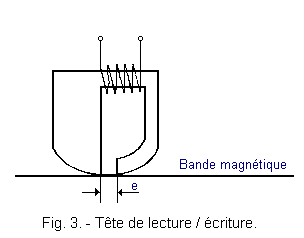
These remanent fields can be converted into electrical pulses, which is what happens on reading.
There are different writing codes. As on the perforated tape, a code is written transversely on several longitudinal tracks.
The data is formatted as blocks of 80 or 200 characters (Figure 4).
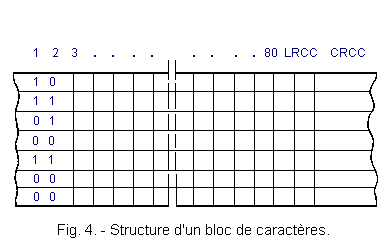
In order to detect read and write errors, we use a parity (or odd) bit that gives the cross parity, as well as two additional characters called LRCC (Length Redundancy Character Check), in French, control character of longitudinal parity and CRCC (Cyclic Redundancy Character Check), in French, character of control of cyclic redundancy.
These last two characters are written, deduced from the data in the information block, by means of a logical operation; by making the reverse operation read, one can know if the block of information has been written correctly on the tape.
1. 3. 2. - MAGNETIC BANDS WITH SOUND FREQUENCY ENCODING (STANDARD KANSAS CITY)
This mode of writing is used mainly in consumer systems and in all cases in low capacity systems (computers or automation).
A standard cassette (Philips type) or a 3M type cartridge (Figure 5) is used, on which bits 1 and 0 are converted into sound frequencies (Figure 6).
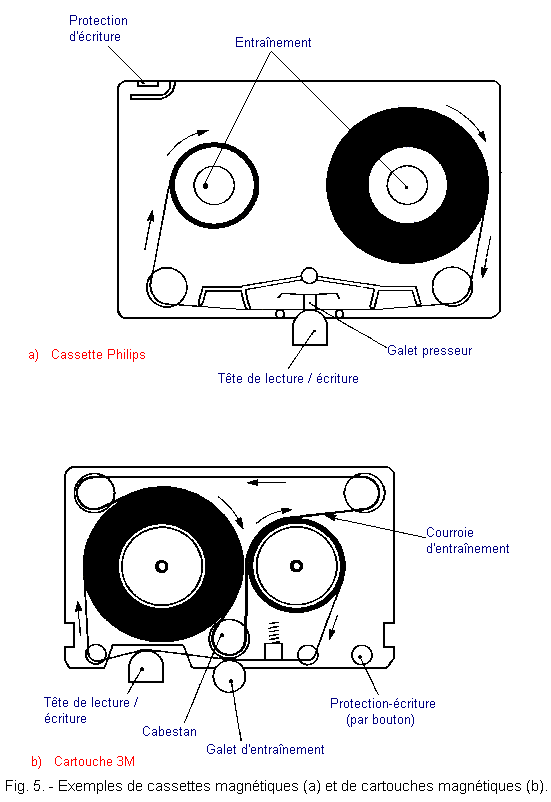
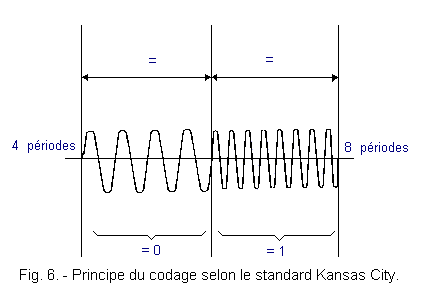
-
4 periods of 1200 Hz represent the 0
-
8 periods of 2400 Hz represent the 1.
This type of writing is analog.
These memories are of series type ; reading and writing are possible.
1. 3. 3. - MAGNETIC CYLINDERS (ANCHORS OF MAGNETIC DISKS) (FIGURE 7)
They are now abandoned.
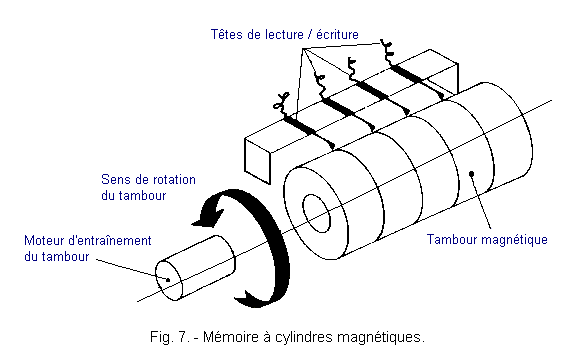
![]() 1. 3. 4. - MAGNETIC DISCS
1. 3. 4. - MAGNETIC DISCS
This evolving technique tends to supplant all other mechanical drive memory systems.
The magnetic support consists of a rigid aluminum disk or a mylar flexible disc, both coated with a magnetic oxide layer, itself covered with an antistatic and lubricating layer.
There are different types of discs :
a) Single discs
-
Immovable hard drives called WINCHESTER.
-
Discs with fixed heads : they are fast but very expensive and today abandoned (Figure 8).
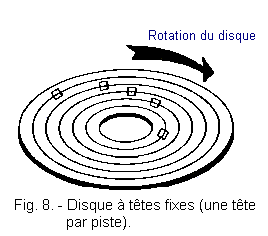
-
Hard drives with single-sided moving heads (Figure 9).
-
Floppy disks or diskettes known as «Floppy discs» of diameter 8 inches, 5 inches 1/4, 3 inches 1/2 (Figure 10).
b) Multiple disks or stacking disks also called «dis-packs» (Figure 11).
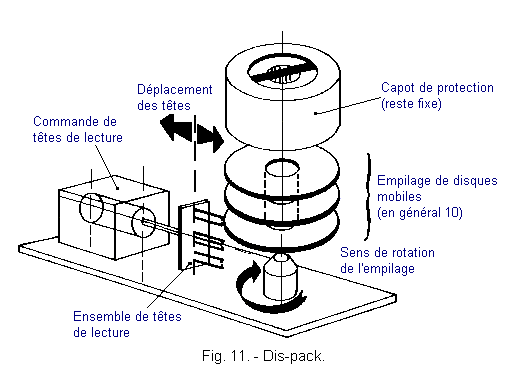
We call «dis-pack» a set of several hard drives connected by their center. As with floppy disks, there are several disk diameters : 14 inches, 8 inches, 5 inches, 3 inches.
Note : 1 inch (English measurement) = 2.54 cm.
1. 3. 5. - ORGANIZING A MAGNETIC DISK (FIGURE 12)
The general organization is common to all the discs.
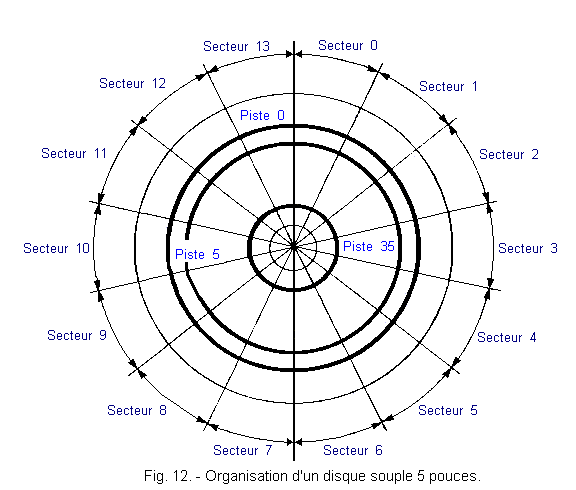
A disk comprises concentric tracks divided into sectors as shown in Figure 12. On each segment thus determined, it is possible to write a certain number of bytes (generally 128 to 256).
Each segment is characterized by an address including the number of the track and that of the sector and in the case of double-sided discs or multiple discs, the number of the face used.
To play on the disc, it will be necessary to move the playhead to position it on the chosen sector and track. We will say that we address the system.
The displacement of the read head is controlled by means of a suitable mechanism. Refer to Figures 9 and 10.
The actual writing is carried out according to the same general principle as that used for the tape writing, but this time, the information being written on only one track, the bits are written in series behind one another others. There is also a control character similar to CRCC.
Figure 13 compares the characteristics of different types of mass memories.
| Support | Capacity type (bytes) | Average access time in seconds |
| Perforated card (80 columns at 600 cards / mn) | 80 | 150 |
| Perforated tape | 120 K | 500 |
| Magnetic card | 5 000 | 10 |
| Magnetic cassette | 300 K | 10 à 100 |
| Minicassette | 64 K | 20 à 150 |
| Floppy disk (1 side, single density) | 300 K | 0,45 |
| Minidisquette | 100 K | 0,8 |
| Magnetic cartridge | 2 M | 20 à 60 |
| Mini cartridge | 270 K | 15 |
| Mini disk rigid 8 inches | 5 M | 0,1 |
| Hard disk 14 inches | < 5 M | 0,08 |
![]() 1. 4. - OPTICAL DISCS
1. 4. - OPTICAL DISCS
These systems are used for the memorization of sounds, they tend to replace the old analog recording discs, so-called microsillons 33 or 45 tours / minute which work thanks to the piezoelectric effect.
The sound signal to be recorded is sampled then quantized and recorded in digital form. The 1 and 0 thus obtained are materialized by the absence or the presence of holes 0.5 µm wide and 0.1 µm deep etched on a disc of nickel-plated synthetic material. The bits are written in series according to a spiral track as in a conventional microgroove, as represented in Figure 14. This writing is done by stamping as for the microgroove discs.
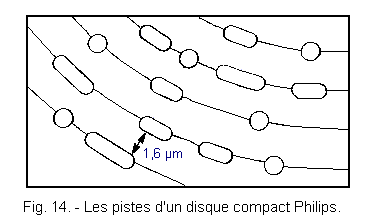
The reading is carried out by means of the coherent beam of light emitted by a laser as illustrated in Figure 15. It passes through the transparent protective layer covering the disk and is reflected on the metal film.
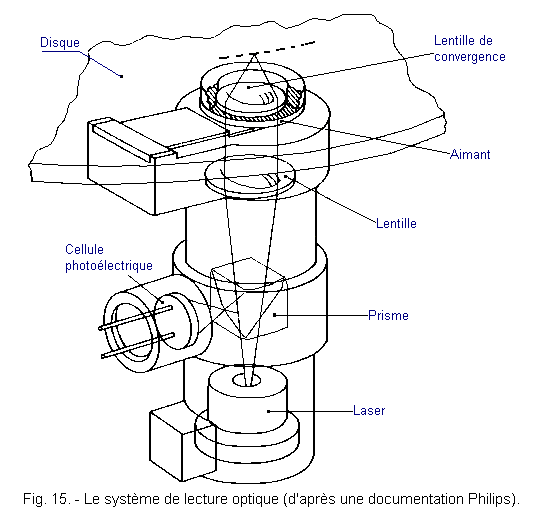
A photoelectric cell analyzes the reflected beam and can thus detect the presence or absence of holes on the explored portion of the track.
The signal highlighted by the photoelectric sensor appears as 1 and 0.
These read only memories, are called to other developments such as the storage of images (Philips videodisc) or even to memorize any type of information.
These memories are currently serial access.
 Click here for the next lesson or in the summary provided for this purpose. Click here for the next lesson or in the summary provided for this purpose. |
|
 Previous Page Previous Page |
 Next Page Next Page |
Nombre de pages vues, à partir de cette date : le 27 Décembre 2019
Envoyez un courrier électronique à Administrateur Web Société pour toute question ou remarque concernant ce site Web.
Version du site : 10. 4. 12 - Site optimisation 1280 x 1024 pixels - Faculté de Nanterre - Dernière modification : 02 Septembre 2016.
Ce site Web a été Créé le, 14 Mars 1999 et ayant Rénové, en Septembre 2016.
 Paper Memories
Paper Memories